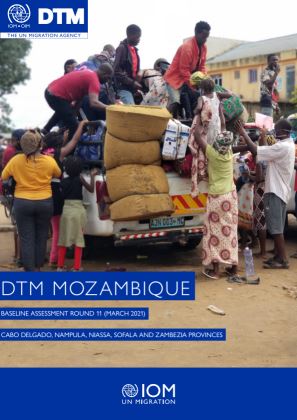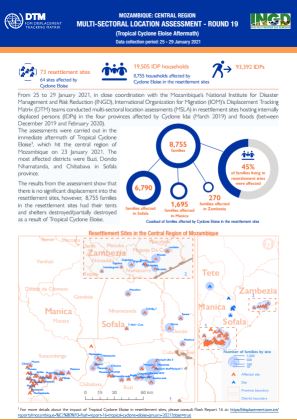-
Countries
-
Data and Analysis
-
Special Focus
-
Crisis Responses
Displacement Report
Country
Title Standard
Mozambique — Displacement Report {#} ({DATE})
Contact
DTM Mozambique, DTMMozambique@iom.int
Type
Component
Domain
Confidential

Contact
DTM Mozambique, DTMMozambique@iom.int
Language
English
Location
Mozambique
Period Covered
Apr 13 2021
Apr 23 2021
Activity
- Mobility Tracking
This Multi-Sectorial Location Assessment (MSLA) report, which presents findings from the International Organization for Migration’s (IOM) Displacement Tracking Matrix (DTM) Round 2 assessments, aims to enhance understanding of the extent of internal displacements and the needs of affected populations in conflict-affected districts of Mozambique’s Cabo Delgado province. The report covers the period from 13 to April 23 2021 and presents trends from 25 assessed sites hosting internally displaced persons across eight districts in Cabo Delgado. In total, 88,704 internally displaced persons (IDPs) or 22,329 households were mapped living in sites assessed during this MSLA. Reported figures, however, exclude displaced individuals living in host community settings. According to DTM Round 11 Baseline, as of March 2021 an estimated 630,241 IDPs were identified in Cabo Delgado.
Sites under assessment in this report included relocation centers, temporary or transit centers, and host community extensions as classified by Camp Coordination Camp Management (CCCM) cluster. Given the active and fluid nature of displacement trends in Northern Mozambique, it is important to note that the number of sites or locations with displaced IDPs exceeds the estimated number of sites assessed for this round. The MSLA included an analysis of sector-wide needs, including shelter and non-food items (NFIs), water, sanitation and hygiene (WASH), food and nutrition, health, education, livelihoods, protection, community engagement and energy. This report pays special attention to the dynamics of forced displacement into sites in the province of Cabo Delgado, which has been hit the hardest by the conflict in Northern Mozambique.

Contact
DTM Mozambique, DTMMozambique@iom.int
Language
English
Location
Mozambique
Period Covered
Mar 01 2021
Mar 31 2021
Activity
- Baseline Assessment
The eleventh round of the DTM Baseline assessment was carried out in 154 localities, located in the provinces of Cabo Delgado (114 localities), Nampula (20 localities), Niassa (12 localities), Sofala (2 localities) and Zambezia (6 localities). As of March 2021, an estimated 630,241 IDPs were identified in Cabo Delgado, while an additional 64,919 IDPs were identified in Nampula, 1,153 in Zambezia, 1,072 in Niassa, and 153 in Sofala. This brings the total number of individuals displaced in the five provinces to 697,538 Internally Displaced Persons, or 150,335 displaced families. All displacements are a result of the insecurity situation in Cabo Delgado province.

Contact
DTM Mozambique, DTMMozambique@iom.int
Language
English
Location
Mozambique
Period Covered
Apr 15 2021
Apr 15 2021
Activity
- Mobility Tracking
- Site Assessment
Following the recent attacks in Palma sede, the IOM’s DTM team conducted a remote assessment on 15 April 2021 in the displacement location of EPC de Quintuda (one of the Quitunda displacement locations currently hosting displaced individuals as a result of the attacks). An estimated 11,104 individuals (1,452 households) are being hosted at this school according to the remote assessment.

Contact
DTM Mozambique, DTMMozambique@iom.int
Language
English
Location
Mozambique
Period Covered
Jan 28 2021
Feb 05 2021
Activity
- Mobility Tracking
- Site Assessment
From 28 January to 05 February 2021, in close coordination with Mozambique’s National Institute for Disaster Management and Risk Reduction (INGD), International Organization for Migration (IOM)’s Displacement Tracking Matrix (DTM) teams conducted multi-sectoral location assessments (MSLA) in accommodation centres hosting internally displaced persons (IDPs) in Manica and Sofala provinces. Multisector assessments were carried in accommodation centers opened after Eloise Cyclone. Population data currently on site is as of the 5th of February.
The assessments were carried out in the immediate aftermath of Tropical Cyclone Eloise, which hit the central region of Mozambique on 23 January 2021. The most affected districts were Buzi, Dondo Nhamatanda, and Chibabava in Sofala province.

Contact
DTM Mozambique, DTMMozambique@iom.int
Language
English
Location
Mozambique
Period Covered
Jan 25 2021
Jan 29 2021
Activity
- Mobility Tracking
- Site Assessment
From 25 to 29 January 2021, in close coordination with the Mozambique’s National Institute for Disaster Management and Risk Reduction (INGD), International Organization for Migration (IOM)’s Displacement Tracking Matrix (DTM) teams conducted multi-sectoral location assessments (MSLA) in resettlement sites hosting internally displaced persons (IDPs) in the four provinces affected by Cyclone Idai (March 2019) and floods (between. December 2019 and February 2020).
The assessments were carried out in the immediate aftermath of Tropical Cyclone Eloise1, which hit the central region of Mozambique on 23 January 2021. The most affected districts were Buzi, Dondo Nhamatanda, and Chibabava in Sofala province.
The results from the assessment show that there is no significant displacement into the resettlement sites, however, 8,755 families in the resettlement sites had their tents and shelters destroyed/partially destroyed as a result of Tropical Cyclone Eloise.

Contact
DTM Mozambique, DTMMozambique@iom.int
Language
English
Location
Mozambique
Period Covered
Nov 05 2020
Nov 06 2020
Activity
- Mobility Tracking
An increase in violent attacks in areas of the Gondola district of Manica, and Chibabava and Buzi districts of Sofala has triggered population movements within the Manica and Sofala provinces. This report presents the results from Displacement Tracking Matrix (DTM) baseline assessments carried out by the International Organization for Migration (IOM) in Manica and Sofala provinces on 5 and 6 November 2020. The aim of the exercise, and subsequent report, is to improve understanding of the scope of internal displacements and the needs of this displaced population.
Through these assessments, IOM identified an estimated 7,038 Internally Displaced Persons (IDPs), or 1,372 households. The majority (54%) of displaced individuals are children, while 28 per cent are women and 18 per cent are men.
Interviewed community leaders and key informants attributed the population movements to the recent increase in attacks by a group called Junta Militar da Renamo and the subsequent fear of insecurity in the aforementioned areas. The displacement identified remains internal to provinces.
In addition, main needs identified by key informants are food, shelter, Water, Sanitation and Hygiene (WASH), access to income-generating activities and access to clean water (all reported in all 5 assessed localities).
Lastly, information detailed in this report include a displacement overview, demographic profile, return intentions, reasons for displacement, places of origin and shelter types, unfulfilled needs of the displaced populations, and a brief sectoral analysis.

Contact
DTM Mozambique, DTMMozambique@iom.int
Language
English
Location
Mozambique
Period Covered
Nov 04 2020
Nov 10 2020
Activity
- Mobility Tracking
From 04 to 10 November 2020, in close coordination with Mozambique’s National Institute for Disaster Management (INGC), International Organization for Migration (IOM)’s Displacement Tracking Matrix (DTM) teams conducted multi-sectoral location assessments (MSLA) in resettlement sites hosting internally displaced persons (IDPs) in the four provinces affected by Cyclone Idai (March 2019) and floods (between December 2019 and February 2020). The DTM teams interviewed key informants, capturing population estimates, mobility patterns, and multi-sectoral needs and vulnerabilities.

Contact
DTM Mozambique, DTMMozambique@iom.int
Language
English
Location
Mozambique
Period Covered
Sep 22 2020
Sep 24 2020
Activity
- Mobility Tracking
- Site Assessment
From 22 to 24 September 2020, in close coordination with Mozambique’s National Institute for Disaster Management (INGC), IOM’s Displacement Tracking Matrix (DTM) teams conducted multi-sectoral location assessments (MSLA) in resettlement sites hosting internally displaced persons (IDPs) in the four provinces affected by Cyclone Idai (March 2019) and floods (between December 2019 and February 2020). The DTM teams interviewed key informants, capturing population estimates, mobility patterns, and multi-sectoral needs and vulnerabilities.

Contact
DTM Mozambique, DTMMozambique@iom.int
Language
English
Location
Mozambique
Period Covered
Aug 25 2020
Sep 03 2020
Activity
- Mobility Tracking
From 25 August to 3 September 2020, in close coordination with Mozambique’s National Institute for Disaster Management (INGC), IOM’s Displacement Tracking Matrix (DTM) teams conducted multi-sectoral location assessments (MSLA) in resettlement sites hosting internally displaced persons (IDPs) in the four provinces affected by Cyclone Idai (March 2019) and floods (between December 2019 and February 2020). The DTM teams interviewed key informants, capturing population estimates, mobility patterns, and multi-sectoral needs and vulnerabilities.

Contact
DTM Mozambique, DTMMozambique@iom.int
Language
English
Location
Mozambique
Period Covered
Jul 22 2020
Jul 25 2020
Activity
- Mobility Tracking
- Site Assessment
From 22 to 25 July 2020, in close coordination with Mozambique’s National Institute for Disaster Management (INGC), IOM’s Displacement Tracking Matrix (DTM) teams conducted multi-sectoral location assessments (MSLA) in resettlement sites in the four provinces affected by Cyclone Idai (March 2019) and the floods (between December 2019 and February 2020). The DTM teams interviewed key informants capturing population estimates, mobility patterns, and multi-sectoral needs and vulnerabilities.
Pagination
- Previous page
- Page 4
- Next page